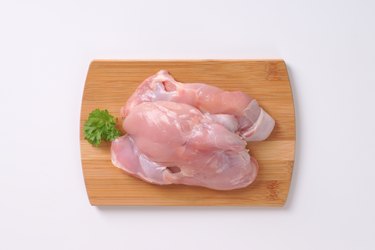
For fans of dark poultry meat who want to stay healthy, boneless skinless sautéed chicken thighs are a great option. They're altogether, tasty, nutritious and fairly simple to throw together for a single meal or for a group.
Sautéed Chicken Thighs Recipe
Video of the Day
According to the Mayo Clinic, sautéing is a healthy cooking technique that boosts flavor and cuts calories. It's a relatively quick way of cooking small pieces of food, and requires only a non-stick pan. With a regular pan, you'll need to use a fat, so the food doesn't stick. You can also use low sodium broth, water or cooking spray.
Video of the Day
Looking for boneless skinless chicken thigh recipes stove top style? Our article, 12 Tips to Keep Chicken Tender and Tasty, offers helpful tips for sautéing chicken. You'll need oil that has a high "smoke point", such as avocado or sunflower oils, chicken thighs and preferred spices or sauces. You can also add vegetables, such as carrots or broccoli, to your stir fry.
- Cut the boneless skinless chicken thighs into small, even pieces.
- Heat the pan, and add oil.
- Add the pieces of chicken to the pan at once, so they finish cooking around the same time. You can also add vegetables at this stage.
- Remove from the heat once golden brown and the internal temperature of the chicken is at least 165 degrees Fahrenheit.
- Serve with a side of rice or potatoes.
Read more: How to Bake a Plain Chicken Breast
Chicken Thighs Nutrition
For those of you who prefer dark meat over white meat, chicken thighs may be a more appealing option than say, chicken breasts. Though according to the Academy of Nutrition and Dietetics, chicken thighs aren't necessarily the healthiest option, at least compared with white meat.
While chicken thighs and chicken breasts are good sources of lean protein, 3 ounces of skinless boneless chicken thighs contain three times the amount of fat as chicken breasts, with chicken breasts containing 3 grams of fat and chicken thighs containing 9 grams. That same amount of chicken breasts contains 140 calories, while chicken thighs contain 170 calories.
The Chicken Council breaks down the nutrition content of skinless chicken thighs even further. A 3 1/2 -ounce portion of chicken thighs contains 26 grams of protein, a large portion of your necessary daily protein intake, 95 milligrams of cholesterol, 88 milligrams of sodium and 1.3 milligrams of iron.
Chicken and Food Safety
If you're going to make sautéed chicken, you'll want to follow food safety precautions to avoid foodborne illness from harmful bacteria. The USDA recommends following four steps to ensure food safety.
Make sure to wash your hands and clean surfaces often to avoid spreading germs, separate raw poultry from other foods so there's no cross contamination, be sure to cook the chicken to an internal temperature of at least 165 degrees Fahrenheit and refrigerate promptly if not eating right away.
Do not defrost chicken at room temperature. Instead, refrigerate, microwave or use cold water to thaw the meat. Leaving chicken out at room temperature can induce bacterial growth. As far as storage, you can keep raw chicken in the refrigerator for up to two days and cooked chicken for up to four days. Raw chicken can be frozen for up to nine months and cooked chicken for up to four months.
- Academy of Nutrition and Dietetics: "Breasts vs Thighs Which Is More Nutritious"
- Mayo Clinic: "Healthy-Cooking Techniques: Boost Flavor and Cut Calories"
- The Organic Kitchen: "One Pan Braised Chicken and Vegetables"
- National Chicken Council: "The Nutritional Value of Chicken"
- USDA: "Chicken From Farm to Table"